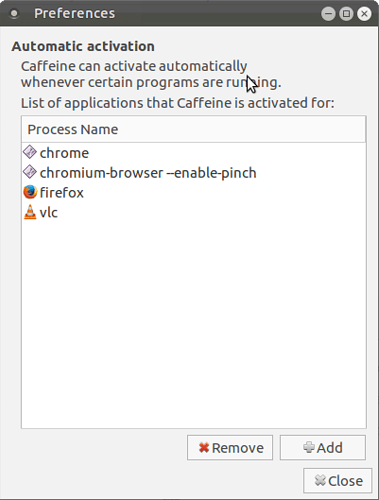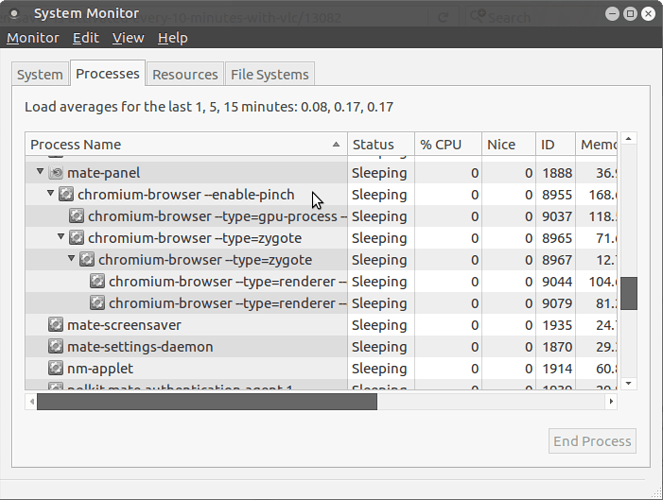Hello everyone, my query is: Why is the screen saver activated every 10 minutes when I am using VLC (which has disabled the screen saver option) if in the configuration of the screensaver I have it to be every 30 minutes and the configuration of Power management I have not activated it.
Thank you.
Make sure it is actually “running” in Control Center > Startup Applications. Any and all screensaver settings will be moot if the actual screensaver of the MATE desktop environment isn’t actually launched. Then it will simply resort to a built-in blank screen functionality.
Screen-savers in Linux are a pain, in my experience.
I always install Caffeine, which works great to kill the screen-saver when ever any programs I have designated are running. However, in my opinion, the latest version of Caffeine is rubbish and so I always use this version:
It will ask if you want to save it or run it directly in Gdebi. It doesn't matter which. But, you might want to save it first so that if you ever reinstall your system, you do not have to go looking for it on the Internet again. In any event, install it with Gdebi.
After installing it, immediately open a terminal and type:
sudo apt-mark hold caffeine
This will stop UM from trying to subsequently "upgrade" Caffeine to the latest version
Following installation, you will find Caffeine in Applications/Accessories
Having once started Caffeine, it should then subsequently load automatically as an indicator at every login on your main top panel.
To use it, click on "preferences" on the indicator.
It should look like this:
You will see I already have some entries in mine. To add an entry, use the "add" button. Usually, all it requires is to type in the name of the application. However, occasionally (as with Chromium browser, for example), this does not work. In which case, with Chromium open, go to your system monitor (this can be found in Applications/System Tools/Mate System Monitor) and look for anything in the "process" tab that has "chromium" in the name of the process. If it has sub-processes, you should ideally pick the top level process. See below:
Whatever you see written there, copy this exactly in the "add" dialog in Caffeine. This should do the trick in allowing Caffeine to detect when Chromium (or any other designated process) is running. When it does detect it, Caffeine will stop all screen-savers. When you close the designated application, Caffeine will then automatically re-allow the screen-saver to operate.
[quote=“stevecook172001, post:3, topic:13082”]I always install Caffeine, which works great to kill the screen-saver[/quote]I can understand the desire to want to install such a package but I fail to see the absolute need. As long as the screensaver is loaded (via Startup) and the configuration is set to not show a screensaver and idle time is set to 2 hours, it should be fine regardless.
I don’t ever see the screensaver popping up. Not even when actually letting it idle for 2 hours or more (watching a movie, for example).
Anyhow, good read regardless. Something to keep in mind.
I am sometimes confused by this as well.
I have a hard time distinguishing mate-screensaver from mate-power-manager.
To me, the two could be merged into a single interface as they share commonalities.
What do others think?
[quote=“orschiro, post:5, topic:13082”]What do others think?[/quote]In this case, I actually agree. Normally I would be cautious about merging too many functionalities into one application and one package but in this case one of the two has such a relatively small role to fulfill that it might be worth it.
Shall we suggest this on Github?
[quote=“orschiro, post:7, topic:13082, full:true”]Shall we suggest this on Github?[/quote]Feel free to do so. My suggestion would be to simply roll mate-screensaver into mate-power-manager. Power manager being the broader scope application. Screensaving could simply be perceived as an extension of power saving. Especially since the nature of screensavers has gone from actually saving your screen.
Screens these days do not actually need screensavers. It’s more of a power management function than anything, in this day and age.
Thank you all for your answers, the problem was in as 1Q7FE6zp said that there was no power manager in the applications in the beginning.
Thank you.
@1Q7FE6zp in case you want to follow the issue on Github:
Good. Very good indeed. I hope it’ll at least be taken under advisement.

